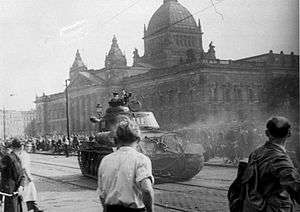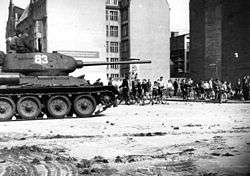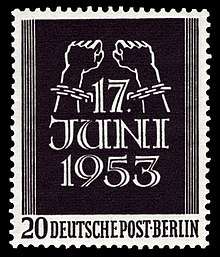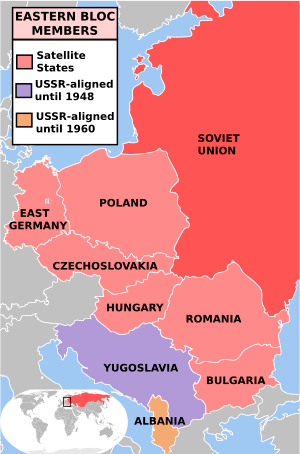Uprising of 1953 in East Germany
| Uprising of 1953 in East Germany | |||||||
|---|---|---|---|---|---|---|---|
| Part of the Cold War | |||||||
 A Soviet IS-2 tank in Leipzig on 17 June 1953 | |||||||
| |||||||
| Belligerents | |||||||
| East German demonstrators | |||||||
| Commanders and leaders | |||||||
|
| |||||||
| Casualties and losses | |||||||
|
55–125 killed [1] 2–4 suicides[2] |
| ||||||
| 17 deaths unaccounted for[2] | |||||||
The Uprising of 1953 in East Germany started with a strike by East Berlin construction workers on 16 June 1953. It turned into a widespread uprising against the German Democratic Republic government the next day. In Germany, the revolt is often called People's Uprising in East Germany (Volksaufstand in der DDR).[3] It involved more than one million people in about 700 localities.[4] 17 June was a public holiday in West Germany up until reunification, and is still a Gedenktag. Strikes and working class networks, particularly relating to the old Social Democratic Party of Germany, anti-fascist resistance networks and trade unions played a key role in the unfolding of the uprising.[5] In Soviet history up to the fall of the Soviet Union the uprising was poorly highlighted[6]
The uprising in East Berlin was violently suppressed by tanks of the Group of Soviet Forces in Germany and the Volkspolizei. In spite of the intervention of Soviet troops, the wave of strikes and protests was not easily brought under control. After June 17, there were demonstrations in more than 500 towns and villages.
Background
In July 1952, the second party conference of the Socialist Unity Party of Germany (SED) took place in East Berlin. In SED General Secretary Walter Ulbricht's words, there was to be the "systematic implementation of Socialism" (planmäßiger Aufbau des Sozialismus); it was decided that the process of Sovietization should be intensified and the importance of the state expanded. The party was acting on demands made by Soviet premier Joseph Stalin.[4]
This meant for example the division of the five Länder into 14 regions (Bezirke) plus East Berlin. This division marked an assault on the remaining middle stratum of the GDR: farmers who owned land and small business owners/tradesmen were being forced to give up their independence through raised charges.
This decision was made amid the background of the catastrophic economic situation in the country. In the course of the militarisation pushed by Soviet authorities, direct and indirect military expenditures rose and already made up around 11% of the national budget in 1952. Together with reparation payments, this totaled over 20% of the budget. The economic policies of the SED favored the development of heavy industry at the expense of the production of food and consumer goods, all of which resulted in a severe crisis in supplying the public with goods. Electricity was turned off in factories and public buildings at the onset of darkness every evening (during peak period).
The dramatic increase of emigration (Republikflucht, brain drain) in the first half of 1953, already high since the establishment of the GDR, constituted a serious economic and social problem. Another factor that contributed to an already complicated political situation was the high number of political prisoners in the GDR. Suppression of the illegal organisation Junge Gemeinde (Young Congregation), wrongly perceived as the central youth organisation of the Evangelical Church, played a role here. Numerous trainee pastors were brutally beaten and imprisoned (e.g. Johannes Hamel and Fritz Hoffmann). Ecclesiastic recreation centres were closed and taken over by the FDJ (e.g.: Schloss Mansfeld and Huberhaus Wernigerode). High school students who belonged to a church were often brutally beaten and expelled by the school authorities, sometimes even shortly before school graduation.
Within this complicated background, the decision to raise the work norms (in short the principle 'more work for the same salary') was perceived as a provocation, which would conceivably lead to the deterioration of living standards. The Central Committee decided to address the economic difficulties with a package of changes, which included higher taxes and higher prices, and—most significantly—an increase of the work quotas by 10%.[7]
These changes were coming into force by 30 June 1953, Ulbricht's 60th birthday. Issued as a suggestion, it became in effect a direction that was introduced in all the state-owned enterprises (so-called volkseigene Betriebe) and if the new quotas were not met then workers would have to face a reduction of salaries. The decision was taken on 13–14 May 1953, and the Council of Ministers approved it on 28 May.
Following Stalin's death on March 5, 1953 and the massive increase in emigration, the new Soviet government decided to ease the policies Stalin had demanded. On 4 June 1953, the Soviet government, alarmed at reports of unrest, summoned East German leaders to Moscow. Georgy Malenkov warned them that if policy direction were not corrected immediately, there would be a catastrophe.[8] After intense discussion the East German party eased policies and publicly admitted that mistakes had been made. However, according to the historian of East Germany, Manfred Wilke, that admission may have had the unintended effect of inflaming public opinion rather than easing tensions.[4]
16 June
On the morning of 16 June, 300 East Berlin construction workers went on strike and marched down Stalinallee, now Karl-Marx-Allee, towards government buildings after their superiors announced a pay cut if they did not meet their work quota. Things started with a discussion by shop stewards as regards how to respond to recent increase in their work quotas. However, this soon turned into a mass demonstration, which gathered more workers from construction sites as they marched first to the headquarters of the Free German Trade Union Federation. However, dissatisfied with the response there, the protest swelled to over ten thousand as they marched to Detlev-Rohwedder-Haus, the home of the House of Ministries in Leipziger Strasse.[5] They bore banners with such slogans as "We demand a quota reduction!"[5] However soon more political demands were developed such as "Workers join us!" "Unity is Strength!" "We want free elections!" and "We want to be free, not slaves."[5] They then demanded that Walter Ulbricht come out to speak to them. When a minor official informed the crowd that their original demand about quotas had been met, this failed to satisfy the protestors who started developing other demands until a young engineer made the suggestion that they put out a call for general strike the next day. These events were reported by the West Berlin-based Radio in the American Sector which helped spread news of the intended strike: “The uprising actually began on June 16, 1953, when construction workers in East Berlin marched down what was then Stalinallee to the seat of the Communist government, demanding that it rescind an increase in work hours and calling for a general strike the next day.” [4] RIAS, however, was initially controlled by the U.S. Information Control Division, with the ICD itself as a department of the Office of Military Government, United States (OMGUS). Formed on May 12th, 1945 from the Psychological Warfare Division of SHAEF (PWD/SHAEF), the ICD was led by Robert A. McClure. The PWD itself had its roots in U.S./U.K. intelligence organizations using staff of the US Office of War Information (OWI) and Office of Strategic Services (OSS) and the British Political Warfare Executive (PWE). Also independent networks which had been formed within the old Social Democratic Party of Germany, which had been forcibly merged into the SED, the trade unions and the Union of Persecutees of the Nazi Regime – which had recently been dissolved by the authorities - were an element in this self-organisation.[5]
17 June

Early on 17 June 40,000 protesters had gathered in East Berlin, with more arriving throughout the morning. Many protests were held throughout East Germany with at least some work stoppages and protests in virtually all industrial centers and large cities in the country. Joint strike committees were established in Hennigsdorf, Görlitz, Cottbus, and Gera.
The original demands of the protesters, such as the reinstatement of the previous lower work quotas, turned into political demands. SED functionaries took to the streets and began arguing with small groups of protesters. Eventually, the workers demanded the resignation of the East German government. The government decided to violently suppress the uprising and turned to the Soviet Union for military support. In total, around 16 Soviet divisions with 20,000 soldiers as well as 8,000 Kasernierte Volkspolizei members were used to quell the uprising.
In East Berlin, major clashes occurred along Unter den Linden (between the Brandenburger Tor and Marx-Engels-Platz), where Soviet troops and Volkspolizei opened fire,[9] and around Potsdamer Platz, where several people were killed by the Volkspolizei.[10] It is still unclear how many people died during the uprising or were sentenced to death in the aftermath. The number of known victims is 55;[11] other estimates put the number of victims at least 125.[12]
Earlier West German estimates of the number of people killed were considerably higher: according to the West German Ministry for Inter-German affairs in 1966, 513 people (including 116 "functionaries of the SED regime") were killed in the uprising, 106 people were executed under martial law or later condemned to death, 1,838 were injured, and 5,100 were arrested (1,200 of these were later sentenced to an average of 5 years in penal camps). It also was alleged that 17 or 18 Soviet soldiers were executed for refusing to shoot demonstrating workers,[13] but these reports remain unconfirmed by post-1990 research.[14]
Reaction by the East German leadership
On 18 June 1953, Neues Deutschland, the official party publication of the Socialist Unity Party of Germany (SED) and the daily national newspaper, published an article on its front page titled "Was ist in Berlin geschehen? (What occurred in Berlin?)" that explained the strike and subsequent uprising to be a direct result of the attempts by "western agencies" to disrupt the national stability and legitimacy of the SED.[15]
Other archived editions of Neues Deutschland document similar comments made by party officials that condemned the influence of American popular culture on German youth. The prominence of American films and music in both East and West Berlin influenced the rise of a subculture of youth commonly known as Halbstarke (lit. half-strengths). American films of the era like The Wild One and Rebel Without a Cause, featuring movie stars Marlon Brando and James Dean, respectively, were viewed by the GDR with romanticizing public disobedience and rebellion, as well as encouraging violent crime. Continued occurrences of crime and uprisings by German youths would eventually lead to the decision by SED party officials to begin construction of the Berlin Wall in 1961.[16]
Legacy


In memory of the 1953 East German rebellion, West Germany established 17 June as a national holiday, called "Day of German Unity". Upon German reunification in October 1990, it was moved to 3 October, the date of formal reunification. The extension of the boulevard Unter den Linden to the west of the Brandenburg Gate, called Charlottenburger Chaussee, was renamed Straße des 17. Juni (English: "17 June Street") following the 1953 rebellion. The event is commemorated in the following poem by Bertolt Brecht:
- The Solution
- After the uprising of the 17th of June
- The Secretary of the Writers Union
- Had leaflets distributed in the Stalinallee
- Stating that the people
- Had forfeited the confidence of the government
- And could win it back only
- By redoubled efforts.
- Would it not be easier
- In that case for the government
- To dissolve the people
- And elect another?
Other prominent GDR authors who dealt with the uprising include Stefan Heym (Fünf Tage im Juni / "Five Days in June", Munich 1974) and Heiner Müller (Wolokolamsker Chaussee III: Das Duell / "Volokolamsk Highway III: The Duel", 1985/86).
West German group Alphaville mention the date explicitly as "the seventeenth of June" but without reference to the year in their 1984 song "Summer in Berlin," from the album Forever Young. When the compilation album Alphaville Amiga Compilation was assembled for release in East Germany in 1988, the song "Summer in Berlin" was submitted for inclusion, but rejected "for political reasons."[17]
The Günter Grass play Die Plebejer proben den Aufstand (The Plebeians Rehearse the Uprising) (1966) depicts Brecht preparing a production of Shakespeare's Coriolanus against the background of the events of 1953.
See also
References
- ↑ http://www.dw.com/en/berlin-commemorates-1953-uprising-in-east-germany/a-39289423 . Retrieved 24 March 2018.
- 1 2 3 http://www.17juni53.de/tote/recherche.html
- ↑ "BStU - Publikationen der Stasi-Unterlagenbehörde - 17. Juni 1953: Volksaufstand in der DDR". Retrieved 21 November 2014.
- 1 2 3 4 Alison Smale (June 17, 2013). "60 Years Later, Germany Recalls Its Anti-Soviet Revolt". The New York Times. Retrieved June 18, 2013.
- 1 2 3 4 5 Dale, Gareth. "East German rising 17 June 1953". academia.edu. Jacobin Magazine. Retrieved 18 June 2017.
- ↑ Водопьянова З. К., Филитов А. М. Почему Семёнов жалеет патроны? // Родина. 2002. № 10. С. 109
- ↑ Wasserstein, Barbarism & Civilization page 494.
- ↑ Otto Grotewohl's notes on meetings between the leaders 2–4 June 1953; see Ostermann, Uprising pages 137–138
- ↑ 17juni53.de: Lagebericht NR. 168 des Operativstabes PDVP (in German), entries 14.32 and 14.42
- ↑ victims include Horst Bernhagen, Edgar Krawetzke, Gerhard Schulze, Oskar Pohl, Gerhard Santura: 17juni53.de: Tote des 17. Juni 1953 (in German)
- ↑ DeutschlandRadio Online, Koeln, Germany. "17juni53.de: Tote des 17. Juni 1953 (in German)". Retrieved 21 November 2014.
- ↑ Tobias Zehnder (30 March 2003). "17juni53.com: Der Volksaufstand (in German)". Archived from the original on 1 February 2015. Retrieved 21 November 2014.
- ↑ DeutschlandRadio Online, Koeln, Germany. "17juni53.de: Die Opfer des Aufstandes (in German, click on the link)". Retrieved 21 November 2014.
- ↑ DeutschlandRadio Online, Koeln, Germany. "17juni53.de: Vermeintliche und ungeklärte Todesfälle: Bezirk Magdeburg (in German)". Retrieved 21 November 2014.
- ↑ Neues Deutschland, Do. 18. Juni 1953, Jahrgang 8
- ↑ Poiger, Uta G. Jazz, Rock, and Rebels: Cold War Politics and American Culture in a Divided Germany. Berkeley, CA: U of California, 2000. Print.
- ↑ Alphaville Discography
Further reading
- Baring, Arnulf. Uprising in East Germany: June 17, 1953 (Cornell University Press, 1972)
- Harman, Chris, Class Struggles in Eastern Europe, 1945-1983 (London, 1988) ISBN 0-906224-47-0
- Millington, Richard (2014). State, Society and Memories of the Uprising of 17 June 1953 in the GDR. Palgrave Macmillan.
- Ostermann, Christian F.; Malcolm Byrne. Uprising in East Germany, 1953. Central European University Press.
- Ostermann, Christian F. "" Keeping the Pot Simmering": The United States and the East German Uprising of 1953." German Studies Review (1996): 61-89. in JSTOR
- Ostermann, Christian F. The United States, the East German Uprising of 1953, and the Limits of Rollback (Working Paper #11. Cold War International History Project, Woodrow Wilson International Center for Scholars, 1994) online
- Richie, Alexandra. Faust's Metropolis: a History of Berlin. New York: Carroll & Graf Publishers, 1998, ch 14
- Sperber, Jonathan. "17 June 1953: Revisiting a German Revolution" German History (2004) 22#4 pp 619–643.
- Tusa, Ann . The Last Division: a History of Berlin, 1945-1989. Reading, Massachusetts: Addison-Wesley, 1997.
- Watry, David M. Diplomacy at the Brink: Eisenhower, Churchill, and Eden in the Cold War. Baton Rouge: Louisiana State University Press, 2014.
- Ilko-Sascha Kowalczuk: 17. Juni 1953. Geschichte eines Aufstands. Beck, München 2013.
External links

- Bibliographical Database of the International Literature on the Uprising of June 17, 1953 in the GDR
- Ulrich Mählert. Der 17. Juni 1953, ein Aufstand für Einheit, Recht und Freiheit. Berlin: J.H.W.Dietz, 2003.
- 1953: The East German uprising on libcom.org
- BBC: Berliner recalls East German uprising (by Ray Furlong)
- Der 16. Juni 1953 bleibt mir unvergesslich Eyewitness report by Peter Bruhn (in German)
- Hope M. Harrison. "Driving the Soviets up the Wall: Soviet-East German Relations, 1953-1961."
- June 17, 1953: Personal memories of the strike leader and political prisoner Karl-Heinz Pahling
- Cold War International History Project Document Collection on the 1953 East German Uprising
- A film clip 1953 anniversary of 1953 East Berlin uprising (1959) is available at the Internet Archive

